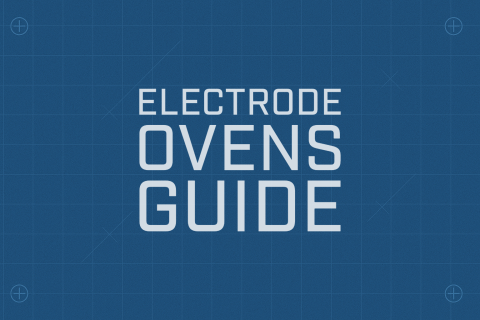Welding electrodes are highly susceptible to moisture and humidity. If not stored correctly, they can absorb water, leading to defects such as porosity, cracking, and hydrogen-induced cracking.
That’s why electrode ovens and quivers are essential in any welding setup. These devices provide a controlled, dry environment to keep electrodes in perfect condition until they’re used.
This guide covers the basics of ovens and quivers, how they work, and what to consider when choosing the right one.
👉 Browse our range of Electrode Ovens & Quivers to keep your consumables in top condition.
In this guide:
What are Welding Electrode Ovens?
Electrode ovens use heat and airflow to keep electrodes dry.
- Portable ovens – compact, designed for on-site work.
- Bench-top ovens – mid-sized, good for workshops.
- Floor-standing ovens – high-capacity, used in fabrication shops.
Key Benefits:
- Prevents weld defects caused by moisture
- Improves electrode performance
- Extends shelf life
- Reduces waste from discarded, damp rods
What are Welding Electrode Quivers?
Quivers are airtight containers that keep electrodes dry, often without heating.
- Vacuum-sealed – maximum moisture protection
- Screw-top – simple, rugged
- Hinged-lid – quick access
Key Benefits:
- Portable protection
- Keeps rods dry on-site
- Prevents reabsorption of moisture after baking
Ovens vs Quivers: Quick Comparison
| Feature | Electrode Ovens | Electrode Quivers |
|---|---|---|
| How it works | Uses heat to maintain temp & airflow | Airtight container (non-heated) |
| Best for | Long-term storage, bulk drying | Short-term use, on-site work |
| Sizes | Portable, bench-top, floor | Belt-mounted, handheld, box |
| Key Benefit | Removes and prevents moisture | Prevents re-absorption in the field |
How to Use Ovens & Quivers
- Check rods first – discard corroded or damaged electrodes.
- Preheat oven – follow electrode manufacturer’s recommended storage temp.
- Load electrodes – close lid securely; ensure airflow fans are working.
- Monitor conditions – check temp & humidity regularly.
- Acclimate before use – allow rods to return to room temp after removal.
Maintenance Tips:
- Clean inside and outside regularly.
- Inspect seals, thermostats, and fans.
- Store units in a cool, dry location.
- Replace damaged or worn parts promptly.
Safety Considerations
- Wear heat-resistant gloves when handling hot electrodes.
- Do not exceed oven capacity (affects airflow & temp control).
- Keep away from flammable materials.
- Never modify or repair heating elements yourself.
- Always follow the manufacturer’s instructions.
Choosing the Right Oven or Quiver
| Factor | What to Consider |
|---|---|
| Capacity | Match to volume of electrodes typically used |
| Temperature Control | Digital thermostats = more precise; basic models = manual |
| Humidity Control | Critical for sensitive electrodes (e.g. low hydrogen rods) |
| Mobility | Portable ovens/quivers for site work; stationary for shops |
| Durability | Rugged build to withstand workshop use |
| Cost vs Features | Balance budget with required performance |
| Warranty & Brand | Choose reputable suppliers with proven track records |
Recommended Electrode Storage Temperatures
| Electrode Type | Typical Classification | Recommended Oven Temp | Notes |
|---|---|---|---|
| Cellulosic | E6010, E6011 | Not stored in ovens | Store in sealed containers at room temp. Oven drying may damage coating. |
| Rutile / General Purpose | E6013, E7014 | 30–100 °C (85–210 °F) | Keep dry; short-term storage in warm oven to remove light moisture. |
| Basic / Low Hydrogen | E7016, E7018, E7018-1, E7028 | 120–150 °C (250–300 °F) | Keep continuously in oven. Re-bake at 260–430 °C (500–800 °F) if moisture suspected. |
| Stainless Steel | E308, E309, E316 | 150–200 °C (300–400 °F) | More sensitive to moisture. Store in quivers during use. |
| Cast Iron (Nickel-based) | ENi-CI, ENiFe-CI | 30–100 °C (85–210 °F) | Store dry. Overheating may damage flux. |
| Hardfacing Electrodes | Various alloy rods | 100–150 °C (210–300 °F) | Depends on manufacturer. Check datasheet for specific alloy guidance. |
⚡ Quick Tips:
- Low hydrogen rods (E7018) are the most critical → they must be stored hot and dry.
- Always use heated quivers on-site to prevent moisture re-absorption once rods leave the oven.
- Never mix different electrode types in the same oven unless temperature requirements match.
- If in doubt → always check the manufacturer’s datasheet for electrode-specific storage instructions.
Final Word
If you’re using MMA electrodes regularly, investing in the right oven and quiver system is not optional – it’s essential. By keeping rods dry and ready for use, you’ll improve weld quality, reduce costly rework, and stay compliant with industry standards.




